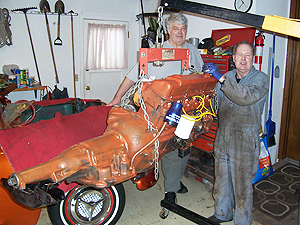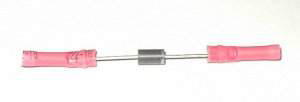Slant-6 into P-15: an engine transplant
By Robin Will
We’re now three chapters into the story of the engine swap in Bob Westphal’s 1948 Plymouth P-15 coupe.
 In Chapter One, the CPPC’s Tech Committee gathered to help Bob strip the engine compartment, pull the head from the original flathead 6, and find out what was going on in there.
In Chapter One, the CPPC’s Tech Committee gathered to help Bob strip the engine compartment, pull the head from the original flathead 6, and find out what was going on in there.
The news wasn’t good: there were broken rings, and worn cylinder bores. It would have taken a rebore, and fitting new oversized pistons – at bare minimum – to make the old engine live again.
At that point, there were lots of options. Rebuild the original engine? Find a fresh old flathead 6? Convert the coupe to V8 power?
Bob found a low-mileage slant-6 that seemed to be the answer, and with Tech Committe help, he hauled it home.
In Chapter 2, the gang gathered to remove the old engine and prepare for the transplant. Some front-end work was done, while the getting was good.
The picture at right is evidence of Chapter 3: test-fitting the “new” slant-6 and automatic transmission.
Jerry Dixon, who was on the scene, reports that the procedure went well. The new bits went in and came out three times before the day was over. Some minor adjustments were necessary to the engine compartment, but a sledgehammer made them easy.
The next step will be the layout and fabrication of new mounts for the engine and transmission.
Stay tuned.
A 12-to-6 volt resistor for dash gauges
 By Bob Westphal
By Bob Westphal
As some in the club know, I am in the process of installing a slant 6 engine in my P-15 Coupe. This swap will necessitate the conversion of my car’s electrical system to 12 volt. This is not a big deal as the 6 volt wiring is of a larger gauge than the 12 volt wiring and is very capable of carrying 12 volts. The lighting can simply be taken care of by exchanging the 6 volt bulbs with 12 volt bulbs. Most of the dash gauges in the early MOPARs are mechanical and aren’t effected by the conversion.
The main problem is the fuel gauge. In my quest to find a simple solution without having one of those bulky resistors that put out high amounts of heat, I came across this very simple solution. It is a small radio type diode runtz volt drop resistor that is spliced into the positive wire to the gauge and costs $4.75 including shipping.
This voltage reducer is designed to operate one 6 volt gauge only. If you need to operate 3 gauges you will need 3 each of these voltage reducers. THESE WILL ONLY WORK ON DASH GAUGES. They WILL NOT work on motors, radios, clocks, horns or lights. THEY ONLY WORK ON DASH GAUGES. For operation of your 6 volt motors and radios use the good old bulky high heat 1 and 1.5 Ohm Resistors.
__________________________________________________________________


